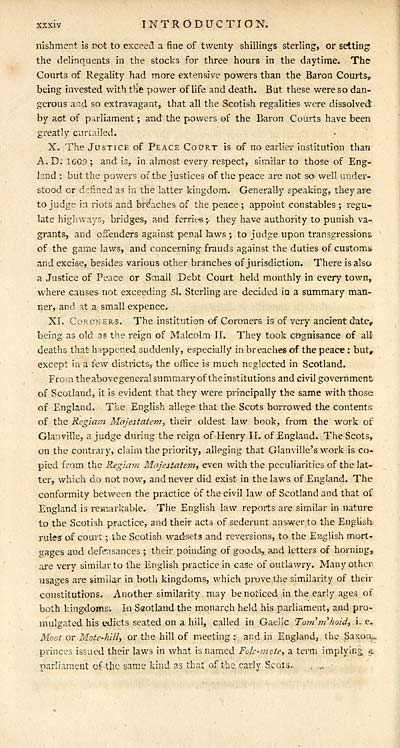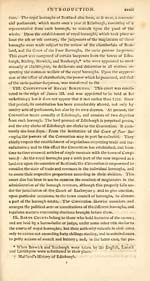Gazetteer of Scotland
(46) Page xxxiv
Download files
Complete book:
Individual page:
Thumbnail gallery: Grid view | List view

xxxiv INTRODUCTION.
nishment is not to exceed a fine of twenty shillings sterling, or setting,
the delinquents in the stocks for three hours in the daytime. The
Courts of Regality had more extensive powers than the Baron Courts?
being invested with the power of life and death. But these were so dan-
gerous and so extravagant, that all the Scotish regalities were dissolved
by aet of parliament ; and the powers of the Baron Courts have been
greatly curtailed.
X. The Justice of Peace Court is of no earlier institution than
A.D. 1609; and is, in almost every respect, similar to those of Eng-
land : but the powers of the justices of the peace are not so- well under-
stood or d .fined as in the latter kingdom. Generally speaking, they are
to judge in riots and breaches of the peace ; appoint constables ; regu-
late highways, bridges, and ferrie« ;. they have authority to punish va-
grants, and offenders against penal laws ; to judge upon transgressions
of the game laws, and concerning frauds against the duties of customs
and excise, besides various other branches of jurisdiction. There is also
a Justice of Peace or Small Debt Court held monthly in every town,
where causes, not exceeding 5l. Sterling are decided iu a summary man-
ner, and at a small expence.
XI. Coroners. The institution of Coroners is of very ancient date?
being as old as the reign of Malcolm II. They took cognisance of all
deaths that happened suddenly, especially in breaches of the peace : but,
except in a few districts, the office is much neglected in Scotland.
From theabovegeneral summary of the institutions and civil government
of Scotland, it is evident that they were principally the same with those
of England. The English allege that the Scots borrowed the contents
of the Reglam Majestatem, their oldest law book, from the work of
Glanville, a judge during the reign of Henry II. of England. The Scots,
on the contrary, claim the priority, alleging that Glanville's work is co-
pied from the Regiam Majestatem, even with the peculiarities of the lat-
ter, which do not now, and never did exist in the laws of England. The
conformity between the practice of the civil law of Scotland and that of
England is remarkable. The English law reports are similar in nature
to the Scotish practice, and their acts of sederunt answer to the English
rules; of court ; the Scotish wadsets and reversions, to the English mort-
gages and defeasances ; their poinding of goods, and letters of horning,
are very similar to the English practice in case of outlawry. Many other
usages are simiia-r in both kingdoms, which prove the similarity of their
constitutions. Another similarity may be noticed in the early ages of
both kingdoms'. In Scotland the monarch held his parliament, and pro-
mulgated his edicts seated on a hill, called in Gaelic Tom'm'hoid, i. e.
Moot or Mote-hill, or the hill of meeting : and in England, the Saxoiv
princes issued their laws in what is named Folc-mcte, a term implying a
parliament of the same kind as that of the .early Scats. . ..
nishment is not to exceed a fine of twenty shillings sterling, or setting,
the delinquents in the stocks for three hours in the daytime. The
Courts of Regality had more extensive powers than the Baron Courts?
being invested with the power of life and death. But these were so dan-
gerous and so extravagant, that all the Scotish regalities were dissolved
by aet of parliament ; and the powers of the Baron Courts have been
greatly curtailed.
X. The Justice of Peace Court is of no earlier institution than
A.D. 1609; and is, in almost every respect, similar to those of Eng-
land : but the powers of the justices of the peace are not so- well under-
stood or d .fined as in the latter kingdom. Generally speaking, they are
to judge in riots and breaches of the peace ; appoint constables ; regu-
late highways, bridges, and ferrie« ;. they have authority to punish va-
grants, and offenders against penal laws ; to judge upon transgressions
of the game laws, and concerning frauds against the duties of customs
and excise, besides various other branches of jurisdiction. There is also
a Justice of Peace or Small Debt Court held monthly in every town,
where causes, not exceeding 5l. Sterling are decided iu a summary man-
ner, and at a small expence.
XI. Coroners. The institution of Coroners is of very ancient date?
being as old as the reign of Malcolm II. They took cognisance of all
deaths that happened suddenly, especially in breaches of the peace : but,
except in a few districts, the office is much neglected in Scotland.
From theabovegeneral summary of the institutions and civil government
of Scotland, it is evident that they were principally the same with those
of England. The English allege that the Scots borrowed the contents
of the Reglam Majestatem, their oldest law book, from the work of
Glanville, a judge during the reign of Henry II. of England. The Scots,
on the contrary, claim the priority, alleging that Glanville's work is co-
pied from the Regiam Majestatem, even with the peculiarities of the lat-
ter, which do not now, and never did exist in the laws of England. The
conformity between the practice of the civil law of Scotland and that of
England is remarkable. The English law reports are similar in nature
to the Scotish practice, and their acts of sederunt answer to the English
rules; of court ; the Scotish wadsets and reversions, to the English mort-
gages and defeasances ; their poinding of goods, and letters of horning,
are very similar to the English practice in case of outlawry. Many other
usages are simiia-r in both kingdoms, which prove the similarity of their
constitutions. Another similarity may be noticed in the early ages of
both kingdoms'. In Scotland the monarch held his parliament, and pro-
mulgated his edicts seated on a hill, called in Gaelic Tom'm'hoid, i. e.
Moot or Mote-hill, or the hill of meeting : and in England, the Saxoiv
princes issued their laws in what is named Folc-mcte, a term implying a
parliament of the same kind as that of the .early Scats. . ..
Set display mode to: Large image | Transcription
Images and transcriptions on this page, including medium image downloads, may be used under the Creative Commons Attribution 4.0 International Licence unless otherwise stated. ![]()
| Gazetteers of Scotland, 1803-1901 > Gazetteer of Scotland > (46) Page xxxiv |
|---|
| Permanent URL | https://digital.nls.uk/97415114 |
|---|

